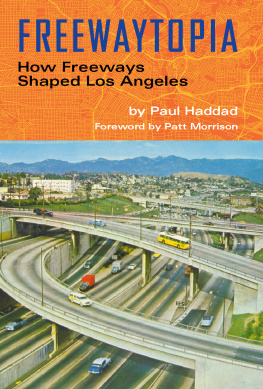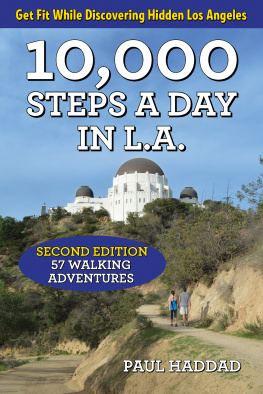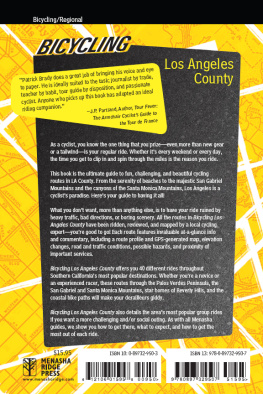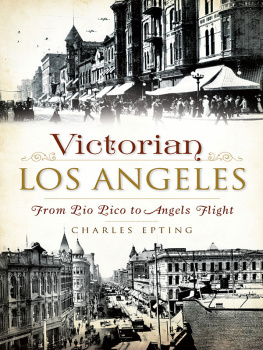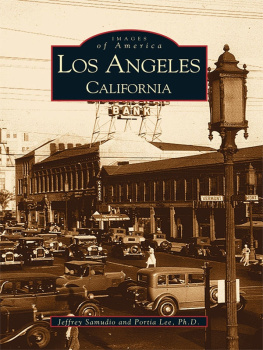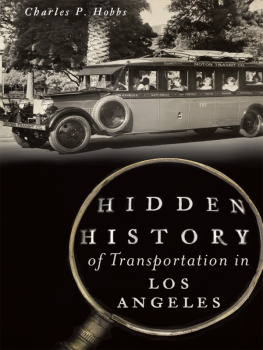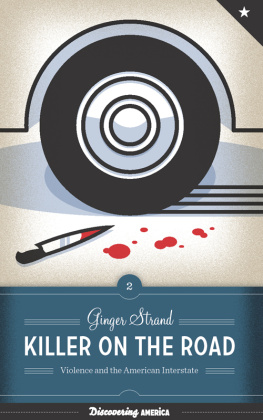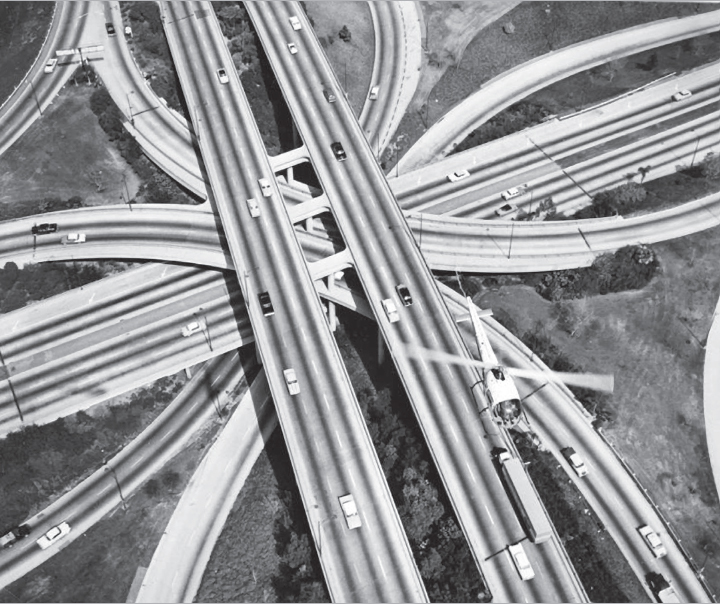Table of Contents
Page List
Guide
FREEWAYTOPIA
How Freeways Shaped Los Angeles
by Paul Haddad
Foreword by Patt Morrison
Copyright 2021 Paul Haddad
All rights reserved.
This book may not be reproduced in whole or in part or in any form or format without the written permission of the publisher.

| Published by: Santa Monica Press LLC P.O. Box 850 Solana Beach, CA 92075 1-800-784-9553 www.santamonicapress.com books@santamonicapress.com |
Printed in the United States
Santa Monica Press books are available at special quantity discounts when purchased in bulk by corporations, organizations, or groups. Please call our Special Sales department at 1-800-784-9553.
ISBN-13 978-1-59580-101-2
Publishers Cataloging-in-Publication data
Names: Haddad, Paul, author. | Morrison, Patt, 1957-, foreword author.
Title: Freewaytopia how freeways shaped Los Angeles / by Paul Haddad; foreword by Patt Morrison.
Description: Includes bibliographical references. | Solana Beach, CA: Santa Monica Press, 2021.
Identifiers: ISBN: 978-1-59580-101-2 (paperback) | 978-1-59580-786-1 (ebook)
Subjects: LCSH Los Angeles (Calif.)--Description and travel. | Los Angeles (Calif.)--History. | Los Angeles (Calif.)--Buildings, structures, etc. | Roads--California--Los Angeles County. | Roads--California--Los Angeles (Calif.) | BISAC TRANSPORTATION / Automotive / History | HISTORY / United States / State & Local / West (AK, CA, CO, HI, ID, MT, NV, UT, WY) | TECHNOLOGY & ENGINEERING / Civil / Highway & Traffic | TECHNOLOGY & ENGINEERING / Civil / Transportation | SOCIAL SCIENCE / Popular Culture
Classification: LCC TE25.L55 H33 2021 | DDC 625.71--dc23
Cover and interior design and production by Future Studio
Maps on pages , by Bryan Duddles.
Front cover photo from authors personal collection.
Back cover photo courtesy of Wikimedia Commons (Bamsb900, CC BY-SA 4.0).
To my family,
for whom freeways were a transport
to some of our greatest adventures
(except the 405, which almost led to our dissolution).
TABLE OF CONTENTS
Each first date refers to the original opening segment of a freeway; the second date refers to a freeways completion.
by Patt Morrison
The iconic Four Level Interchange, 1959
Freeways are what we are.
GEORGE TAKEI, Sulu of Star Trek
Los Angeles in 1946 before the completion of a single freeway. Note the proliferation of oil wells in the coastal plain and agricultural fields in the Valley.
FOREWORD
by Patt Morrison
Its Los Angeles, not Rome. Here, all roads lead to more roads. Our lore and stories speak of the beach, of Hollywood, and of that other constant on our landscapefreeways.
You know more about freeways than you think you doand much less than Paul Haddad does. With verve and authority, he loops you in in Freewaytopia, an encyclopedic, anecdotal and photographic history of Los Angeles Countys two dozen freeways.
Now, -topia can be preceded by u- and by dys-, and Haddad acknowledges both. Here is homage to the lyrical prose and praise for freeways from California native and onetime Corvette Stingray driver Joan Didion, and from the influential English architectural critic Reyner Banham, who found a kind of Zen coherence in the Autopia of freeways.
Human lives were once described as nasty, brutish and short; our freeways, with their carnage and road rage, can be nasty, brutish and endless, and yet they have forged, for good and ill, the Southern California lifestyle in a way that even Hollywood cannot match. Our expectations for the freeways nonstop door-to-door mobility delivers us to our destinations but also disconnects us from the happenstance of seeing and knowing the neighborhoods between points A and Bfrom knowing our own city.
Open to almost any page and youll find a saga, a drama, a nugget to amaze your friends, like the many names and nicknames any freeway has had, as if they were Tolstoy heroines. The Long Beach Freeway was originally the Los Angeles River Freeway, the San Diego Freeway was the Sepulveda Freeway. (I was quoted a few times in these pages, once about my campaign for the stubby Marina Freeway to be named not for that manmade feature but for a natural one, the Ballona Freeway.)
Freewaytopia is an L.A. scrapbook of the momentous and the trivialpranksters, mayhem, catastrophes natural and manmade, the fathers of the SigAlert and of the Botts Dots that go bump in the night and the day, Mayor Sam Yortys up-in-the-air upstaging of the governor of California at the opening of the 405, and why, to the perplexity of newcomers and visitors, we use the definite article the for our freeways, like the 210, the 405, the Harbor, the Santa Monica, the Golden State (which gave its name to a serial killer).
What elbows through these pages most profoundly and consistently, from the planning for the 1940 Arroyo Seco Parkway to the Century Freeway, opened in 1993 and correctly named the Glenn Anderson Freeway (the Glenn, said no one, ever), is the arrogance and ruthlessness of the freeway planners and their backers.
Just like the hammer to which everything is a nail, to these builders, virtually every traffic problem could be solved by building another freeway. In the way that Robert Moses hammered apart New York neighborhoods with expressways and urban makeovers, freeway planners policies prioritized practicality, rapidity, and efficiency over quality of life concerns.
Part of the headlong rush to web L.A. with freeways was because a federal interstate budget at one point footed 90% of the bill for freeways, an irresistible incentive. And part of it smacked of urban renewal as freeways stomped through established neighborhoods like Godzilla with a cement mixer. Thousands of homes were leveled, thousands of families displaced. The Santa Monica Freeway blithely sundered Black neighborhoods near Downtown and near the ocean. The Hollywood Freeway smashed through dozens of grand old houses, two of which had belonged to Rudolph Valentino and Charlie Chaplin. The Century Freeway took out the Beach Boys family home and shattered Black communities. Farther north, one man who had just been forced to move to make way for the Hollywood Freeway found out that hed have to abandon his new house to make way for the Golden State Freeway.
The massive East L.A. Interchange blasted apart the character and closeness of neighborhoods, and Haddad found that real estate appraisal agents for the states highway division had contemptuously characterized East L.A. as infiltrated by minority groups, mostly [of] Latin derivation.
It was characteristic of the casual racism of planning that marks L.A. to this day. And when opposition to freeways reached a critical mass, with the voices of whiter and more prosperous communities, along with a burgeoning environmental and social justice awareness, freeway-building finally began to take its foot off the accelerator.

